Research on the Construction and Application of Rural Digital Design Ecosystem under the “Dual Carbon” Goal—Take the Carbon Sequestration Benefits of Street Trees in Nanjing’s Bulao Village as an Example
Abstract
:1. Introduction
2. Materials and Methods
2.1. Overview of the Study Area
2.2. Data Analysis
2.3. Establishing a Theoretical Framework for Rural Digital Design Ecosystems
3. Results
3.1. Street Tree Structure of the Bulao Village
3.2. Carbon Sequestration Benefits of Street Trees in Bulao Village
4. Discussion
4.1. Structural Characteristics of the Digital Design Ecosystem
4.1.1. Subject Virtualization
4.1.2. Digitization of Elements
4.1.3. Systematization of Relationships
4.2. Plant Optimization and Improvement Strategy of a Parking Lot in Bulao Village
5. Conclusions
Author Contributions
Funding
Data Availability Statement
Conflicts of Interest
References
- Zhao, D.Q.; Ding, Y.W. The mechanism, path and countermeasures of digitalization to promote rural revitalization. J. Hunan Univ. Sci. Technol. (Soc. Sci. Ed.) 2021, 24, 112–120. [Google Scholar]
- Xinhua News Agency. The CPC Central Committee and the State Council Issued the Rural Revitalization Strategic Plan (2018–2022) [EB/OL]. Available online: https://www.gov.cn/zhengce/2018-09/26/content_5325534.htm (accessed on 26 August 2018).
- Xinhua News Agency. The Cyberspace Administration of China and Other Ten Departments Issued the Action Plan for Digital Rural Development (2022–2025) [EB/OL]. Available online: https://www.gov.cn/xinwen/2022-01/26/content_5670637.htm (accessed on 26 January 2022).
- Adner, R. Ecosystem as structure: An actionable construct for strategy. J. Manag. 2017, 43, 39–58. [Google Scholar] [CrossRef]
- Ma, H.; Hou, H.; Liu, C. Ecosystem Strategy in the Digital Economy: An ECO framework. Tsinghua Manag. Rev. 2021, 36, 24–33. [Google Scholar]
- Jacobides, M.G.; Cennamo, C.; Gawer, A. Towards a theory of ecosystems. Strateg. Manag. J. 2018, 39, 2255–2276. [Google Scholar] [CrossRef]
- Liu, J.Y.; Liu, C.Y. The Rural Poverty Reduction Effect of Digital Financial Inclusion: Effects and Mechanisms. Financ. Ser. 2020, 255, 43–53. [Google Scholar]
- Zeng, Y.W.; Song, Y.X.; Lin, X.Z.; Fu, C.L. Several issues in China’s digital village construction were discussed. China’s Rural. Econ. 2021, 4, 21–35. [Google Scholar]
- Lu, R.J.; Yu, R.J. The value implications and practical path of digitalization to help the integration and innovative development of rural cultural tourism industry. Nanjing Soc. Sci. 2022, 5, 152–158. [Google Scholar]
- Kashan, A.J.; Mohannak, K. Dynamics of industry architecture and firms’ knowledge and capability development: An empirical study of industry transformation. Technol. Anal. Strateg. Manag. 2017, 29, 687–700. [Google Scholar] [CrossRef]
- Hu, H.B.; Huang, T.; Zeng, Q.F.; Zhang, S. The role of institutional entrepreneurship in building digital ecosystem: A case study of Red Collar Group (RCG). Int. J. Inf. Manag. 2016, 36, 496–499. [Google Scholar] [CrossRef]
- Li, H.Y. The digital agricultural innovation ecosystem’s formation mechanism and implementation path. Agric. Econ. Issues 2022, 5, 49–59. [Google Scholar]
- Cohen, B.; Amoros, J.E.; Lundy, L. The generative potential of emerging technology to support startups and new ecosystems. Bus. Horiz. 2017, 60, 741–745. [Google Scholar] [CrossRef]
- Katz, R.; Callorda, F. Accelerating the development of the Latin American digital ecosystem and implications for broadband policy. Telecommun. Policy 2018, 42, 661–681. [Google Scholar] [CrossRef]
- Bu, Y.F. Digital Ecosystem: A Market Picture for All-Media Communication. Mod. Audiov. 2019, 7, 1. [Google Scholar]
- Xue, N.; Han, T.M.; Zhu, C.Y. Digital Economy Empowers Rural Agriculture Revitalization: Architecture and Implementation Mechanism of Agricultural Platform Ecosystem. Southwest Financ. 2022, 3, 58–67. [Google Scholar]
- Markard, J.; Truffer, B. Technological innovation systems and the multi-level perspective: Towards an integrated framework. Res. Policy 2008, 37, 596–615. [Google Scholar] [CrossRef]
- Malerba, F. Sectoral systems of innovation and production. Res. Policy 2002, 31, 247–264. [Google Scholar] [CrossRef]
- Nelson, R. National Innovation Systems: A Comparative Analysis; Oxford University Press: New York, NY, USA, 1993; p. 541. [Google Scholar]
- Pekkarinen, S.; Harmaakorpi, V. Building regional innovation networks: The definition of an age business core process in a regional innovation system. Reg. Stud. 2006, 40, 401–413. [Google Scholar] [CrossRef]
- Moore, J. Business ecosystems and the view from the firm. J. Index. Metr. 2006, 54, 31. [Google Scholar] [CrossRef]
- Bu, H.L.C.; Chen, L. Digital innovation ecosystem: Concept, structure, and mechanism. China Sci. Technol. Forum 2022, 317, 54–62. [Google Scholar]
- Eisenhardt, K.M.; Martin, J.A. Dynamic capabilities: What are they? Strateg. Manag. J. 2000, 21, 1105–1121. [Google Scholar] [CrossRef]
- Kleemann, N.; Kanbach, D.K. Toward a taxonomy of dynamic capabilities—A systematic literature review. Manag. Res. Rev. 2021, 45, 486–501. [Google Scholar] [CrossRef]
- Helfat, C.E.; Raubitschek, R.S. Dynamic and integrative capabilities for profiting from innovation in digital platform-based ecosystems. Res. Policy 2018, 47, 1391–1399. [Google Scholar] [CrossRef]
- Zhang, W.W.; Jin, H.; Leng, J.X. How Smart City Construction Helps Modernize Social Governance?—Hangzhou’s “City Brain” under the Test of the New Crown Epidemic. J. Zhejiang Univ. (Humanit. Soc. Sci. Ed.) 2020, 50, 117–129. [Google Scholar]
- Linde, L.; Sjodin, D.; Parida, V. Dynamic capabilities for ecosystem orchestration: A capability-based framework for innovative city innovation initiatives. Technol. Forecast. Soc. Chang. 2021, 166, 120614. [Google Scholar] [CrossRef]
- Muhic, M.; Bengtsson, L. Dynamic capabilities triggered by cloud sourcing: A stage-based model of business model innovation. Rev. Manag. Sci. 2019, 15, 33–54. [Google Scholar] [CrossRef]
- Eggers, J.P.; Kaplan, S. Cognition and capabilities: A multi-level perspective. Acad. Manag. Ann. 2013, 7, 295–340. [Google Scholar] [CrossRef]
- Alinaghian, L.; Kim, Y.; Srai, J. A relational embeddedness perspective on dynamic capabilities: A grounded investigation of buyer-supplier routines. Ind. Mark. Manag. 2020, 85, 110–125. [Google Scholar] [CrossRef]
- Kanninen, T.; Penttinen, E.; Tinnila, M.; Kaario, K. Exploring the dynamic capabilities required for sterilization: The case process industry. Bus. Process Manag. J. 2017, 23, 226–247. [Google Scholar] [CrossRef]
- Gebauer, H. Exploring the contribution of management innovation to the evolution of dynamic capabilities. Ind. Mark. Manag. 2011, 40, 1238–1250. [Google Scholar] [CrossRef]
- Mousavi, S.; Bossink, B.A. Firms’ capabilities for sustainable innovation: The case of biofuel for aviation. J. Clean. Prod. 2017, 167, 1263–1275. [Google Scholar] [CrossRef]
- Dixon, S.; Meyer, K.; Day, M. Building dynamic capabilities of adaptation and innovation: A study of micro-foundations in a transition economy. Long-Range Plan. 2014, 47, 186–205. [Google Scholar] [CrossRef]
- Pandit, D.; Joshi, M.P.; Sahay, A.; Gupta, R.K. Disruptive innovation and dynamic capabilities in emerging economies: Evidence from the Indian automotive sector. Technol. Forecast. Soc. Chang. 2018, 129, 323–329. [Google Scholar] [CrossRef]
- Makkonen, H.; Pohjola, M.; Olkkonen, R.; Koponen, A. Dynamic capabilities and firm performance in a financial crisis. J. Bus. Res. 2014, 67, 2707–2719. [Google Scholar] [CrossRef]
- Birkinshaw, J.; Zimmermann, A.; Raisch, S. How do firms adapt to discontinuous change? Bridging the dynamic capabilities and ambidexterity perspectives. Calif. Manag. Rev. 2016, 58, 36–58. [Google Scholar] [CrossRef]
- Day, G.S.; Shoemaker, P.J. Adapting to fast-changing markets and technologies. Calif. Manag. Rev. 2016, 58, 59–77. [Google Scholar] [CrossRef]
- Gueler, M.S.; Schneider, S. The resource-based view in business ecosystems: A perspective on the determinants of a valuable resource and capability. J. Bus. Res. 2021, 133, 158–169. [Google Scholar] [CrossRef]
- Heaton, S.; Siegel, D.S.; Teece, D.J. Universities and innovation ecosystems: A dynamic capabilities perspective. Ind. Corp. Chang. 2019, 28, 921–939. [Google Scholar] [CrossRef]
- Feng, Y.M.; Wang, L.; Zhao, W.J.; Lv, C.Y. Carbon storage and distribution pattern of spruce plantation with different stand densities. J. Cent. South Univ. For. Technol. 2022, 42, 112–121,174. [Google Scholar]
- Zhou, B.N.; Lu, J.G.; Hua, Z.Z. Research on the Ecological Service Benefits of Urban Greenway Based on i-Tree Model. Zhejiang J. Agric. Sci. 2020, 32, 2201–2210. [Google Scholar]
- Qian, P.F.; Chen, G.H.; Wen, L. The platform studies international progress and focus and policy implications. Dev. Stud. 2014, 5, 80–83. [Google Scholar]
- Zhang, C.; Chen, K.H.; Mu, R.P. Digital Innovation Ecosystem: Theoretical Construction and Future Research. Res. Manag. 2021, 42, 1–11. [Google Scholar]
- Development Research Center of the State Council. Digital Transformation: Development and Policy; China Development Press: Beijing, China, 2022. [Google Scholar]
- Xinhua News Agency. The Opinions of the CPC Central Committee and the State Council on Building a Perfect System and Mechanism for Market-Oriented Allocation of Factors [EB/OL]. Available online: http://www.gov.cn/zhengce/2020-04/09/content_5500622.htm (accessed on 8 March 2023).
- Wang, Q.; Fu, X.D. Exploring the mechanism of data elements to empower economic growth. Shanghai Econ. Res. 2021, 4, 55–66. [Google Scholar]
- Xie, K.; Yi, F.M.; Gu, F.T. Digital transformation and innovation in the agriculture driven by big data. Agric. Econ. Issues 2022, 05, 37–48. [Google Scholar]
- Wang, J.M.; Fan, L.Y.X.; Han, D.; Chen, L. Study on Quantification and Allocation Model of Carbon Sink Matrix of Green Land Plants in Xi’an under the “Dual Carbon” Goal. Chin. Gard. 2023, 39, 108–113. [Google Scholar]

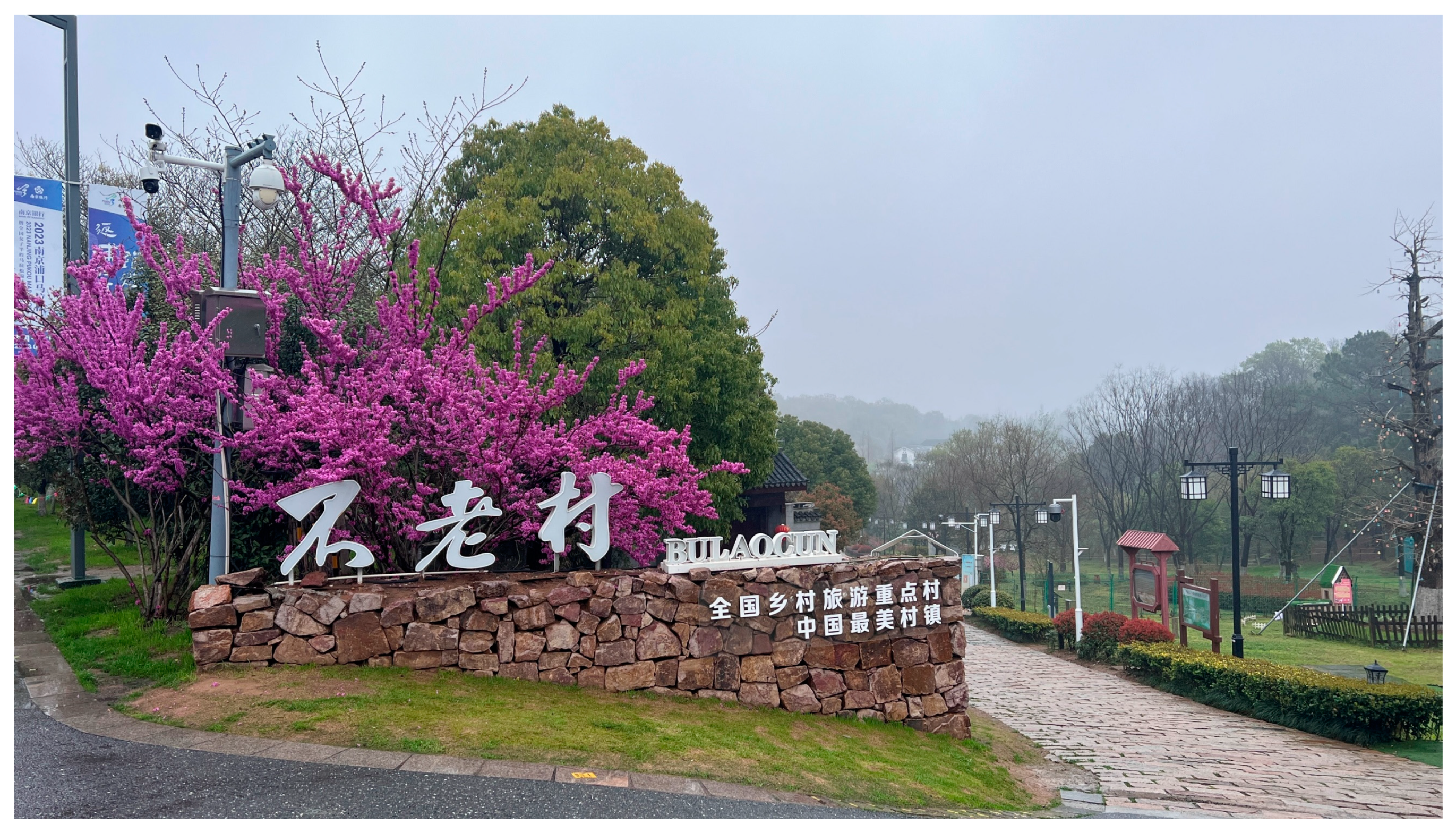
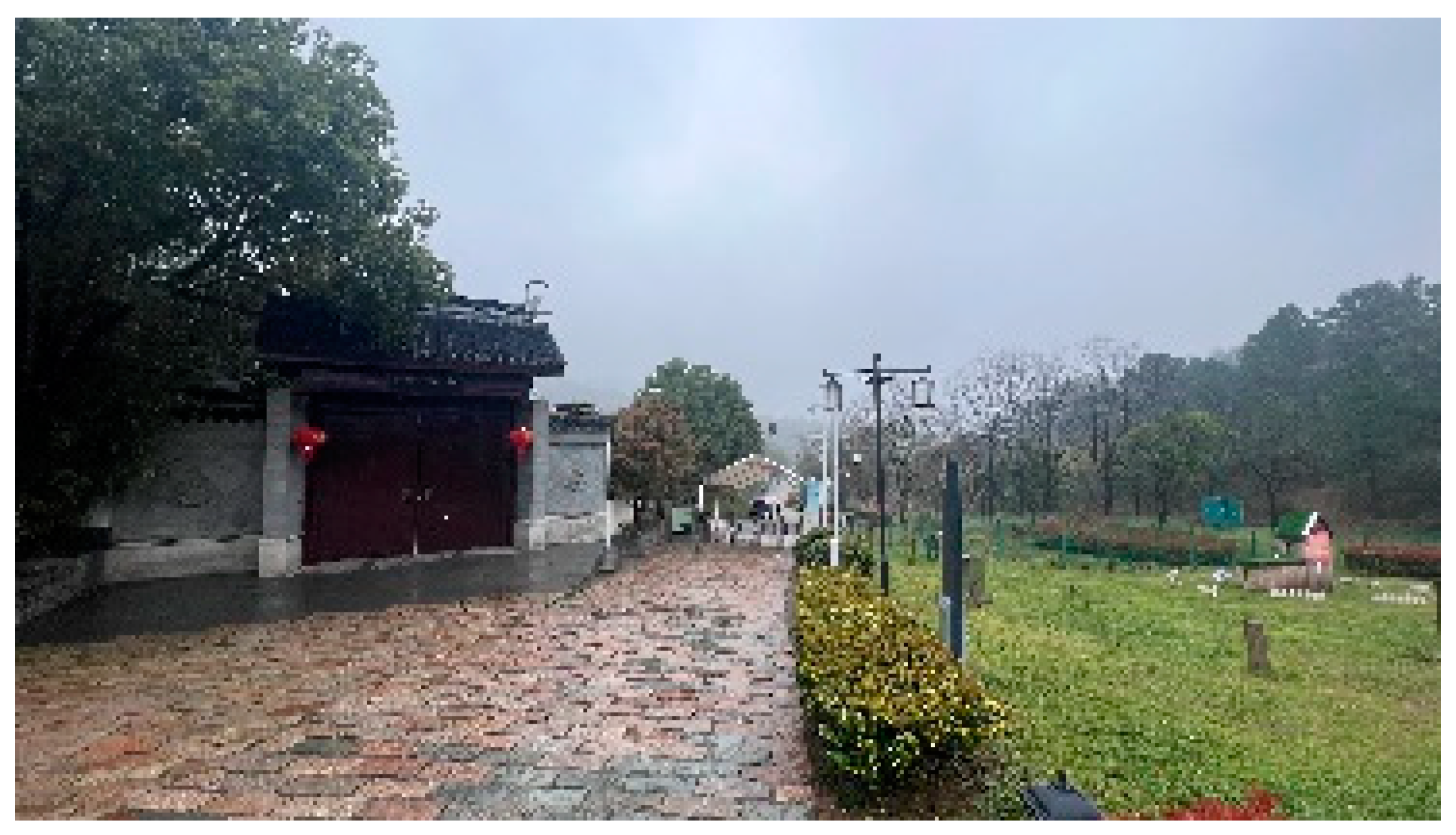
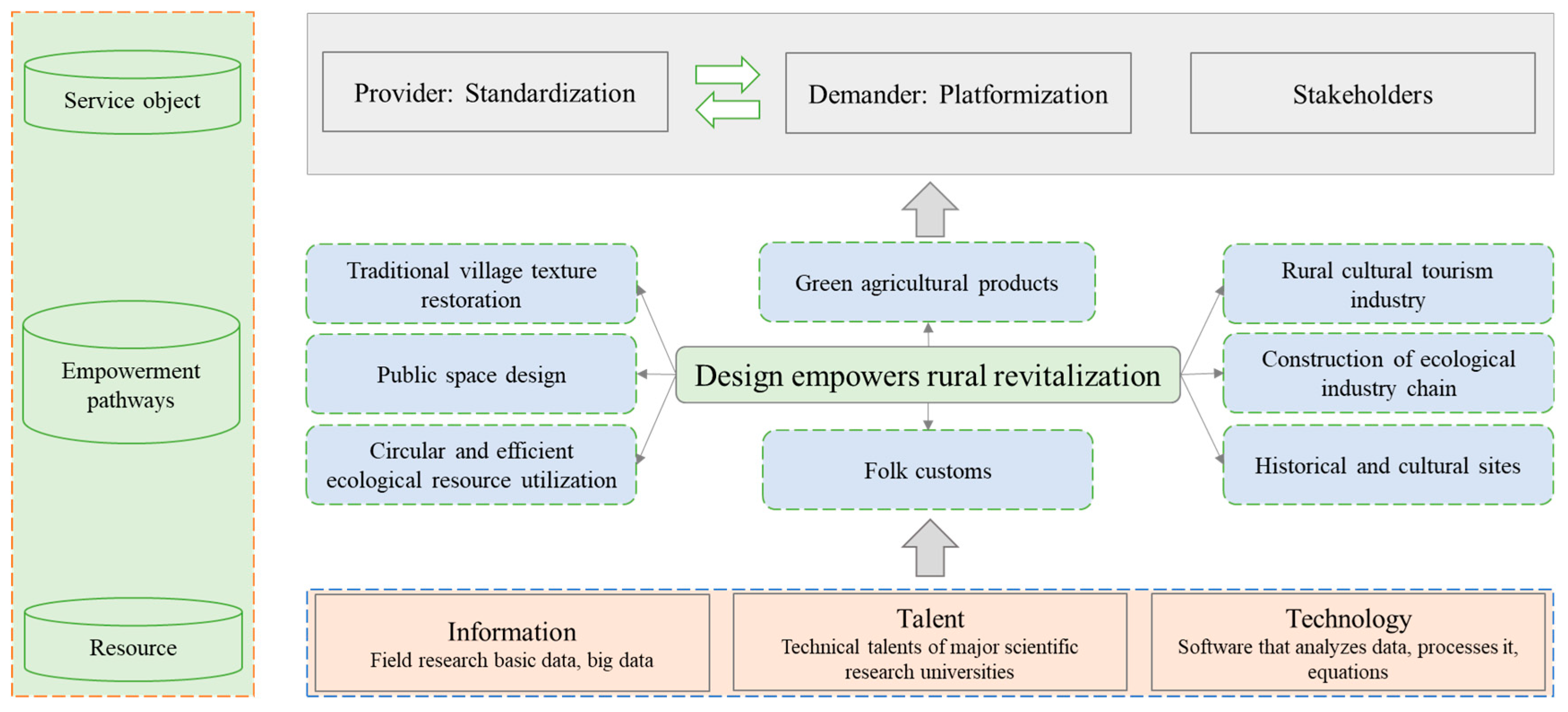


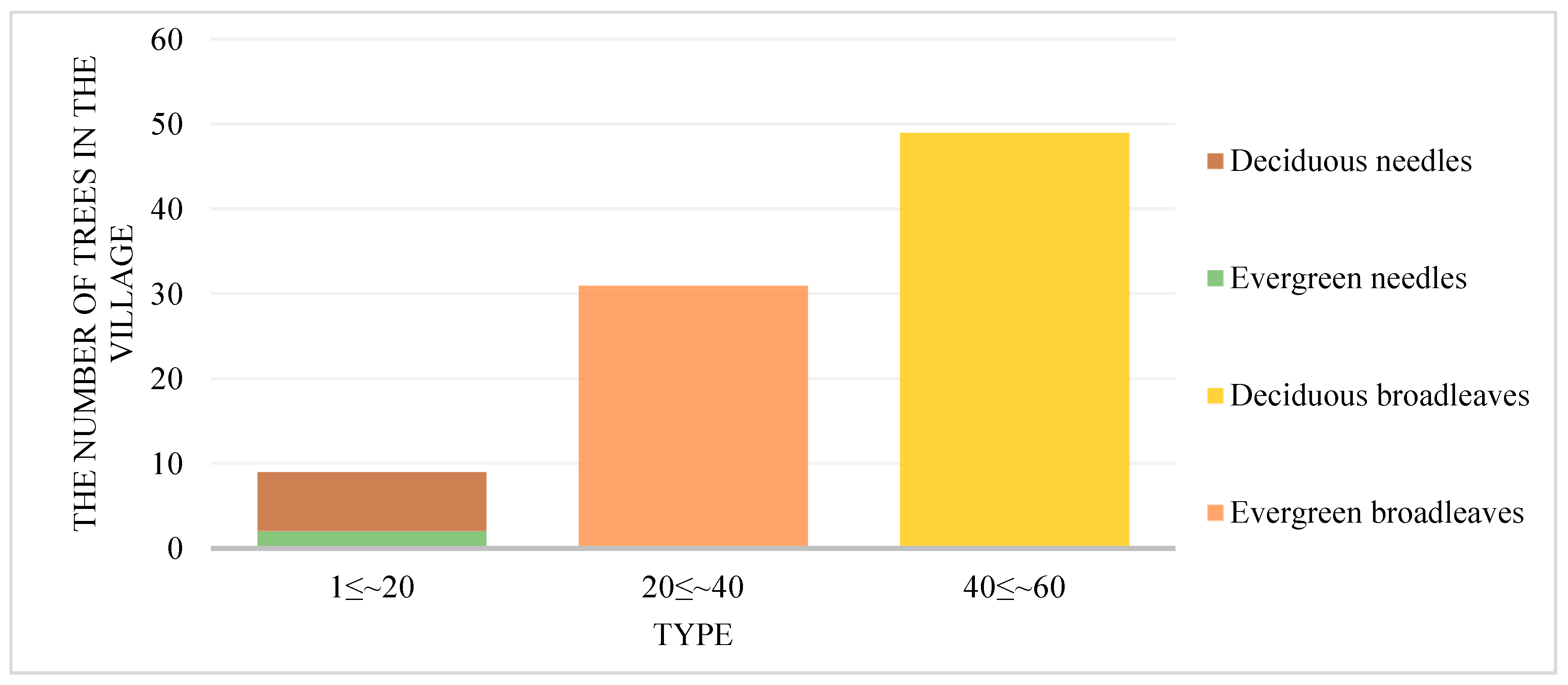
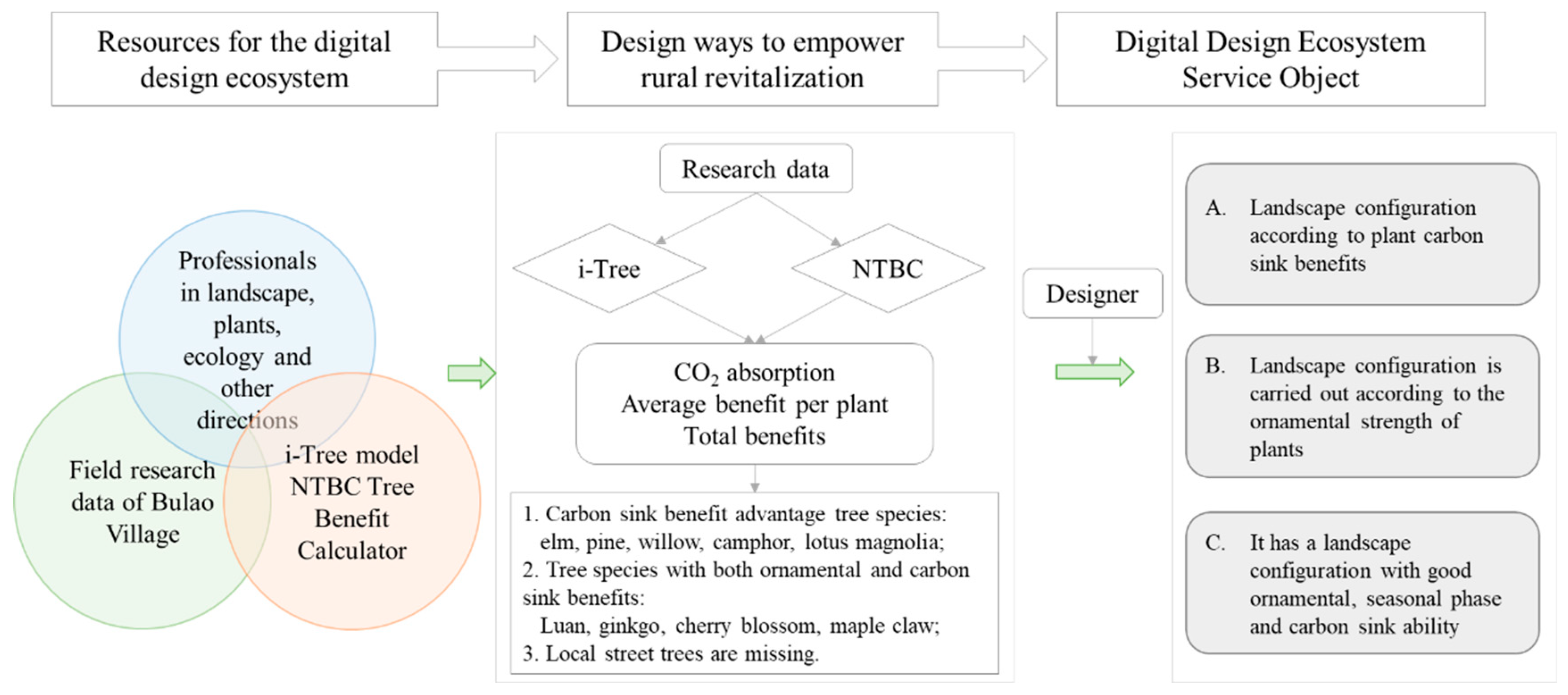
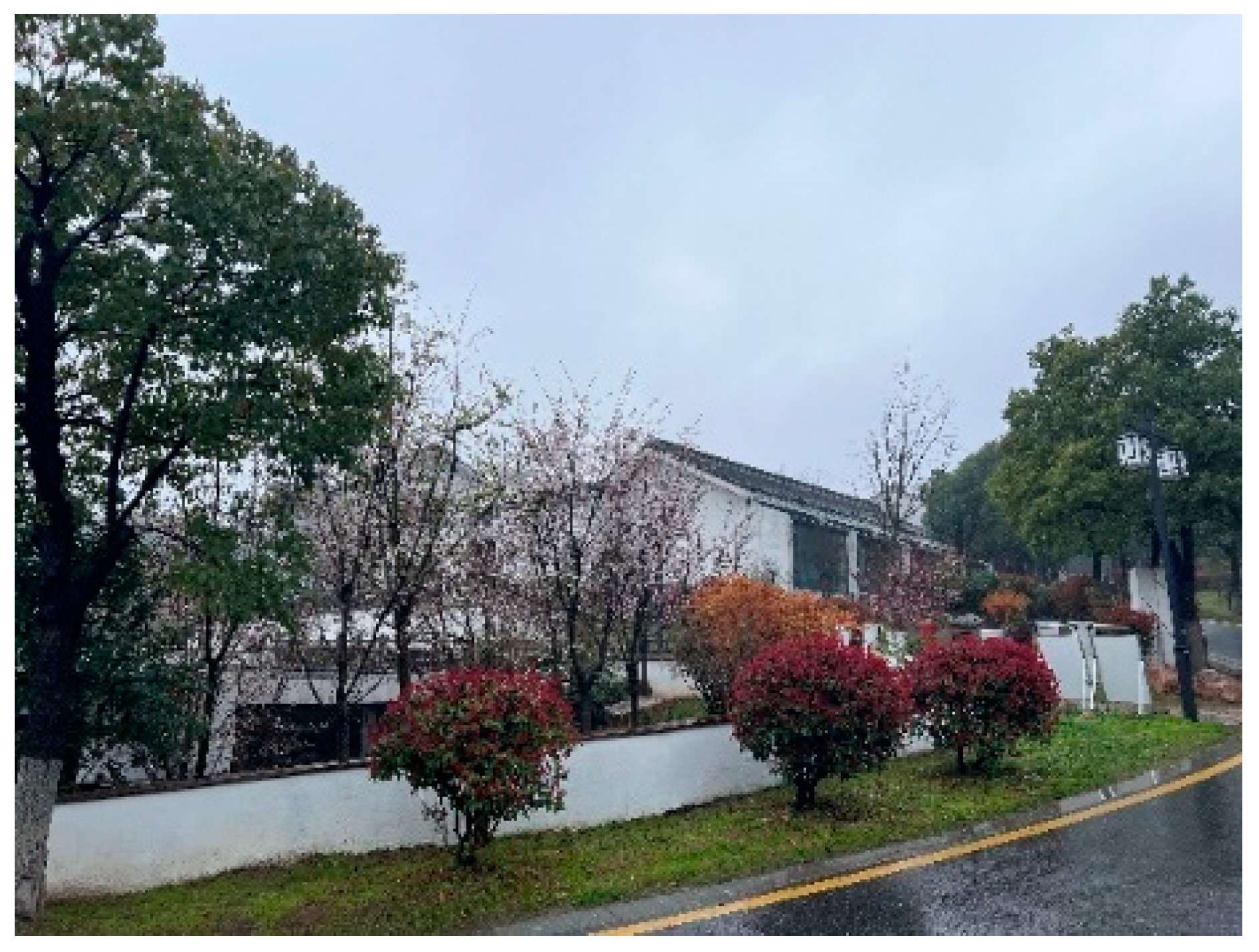
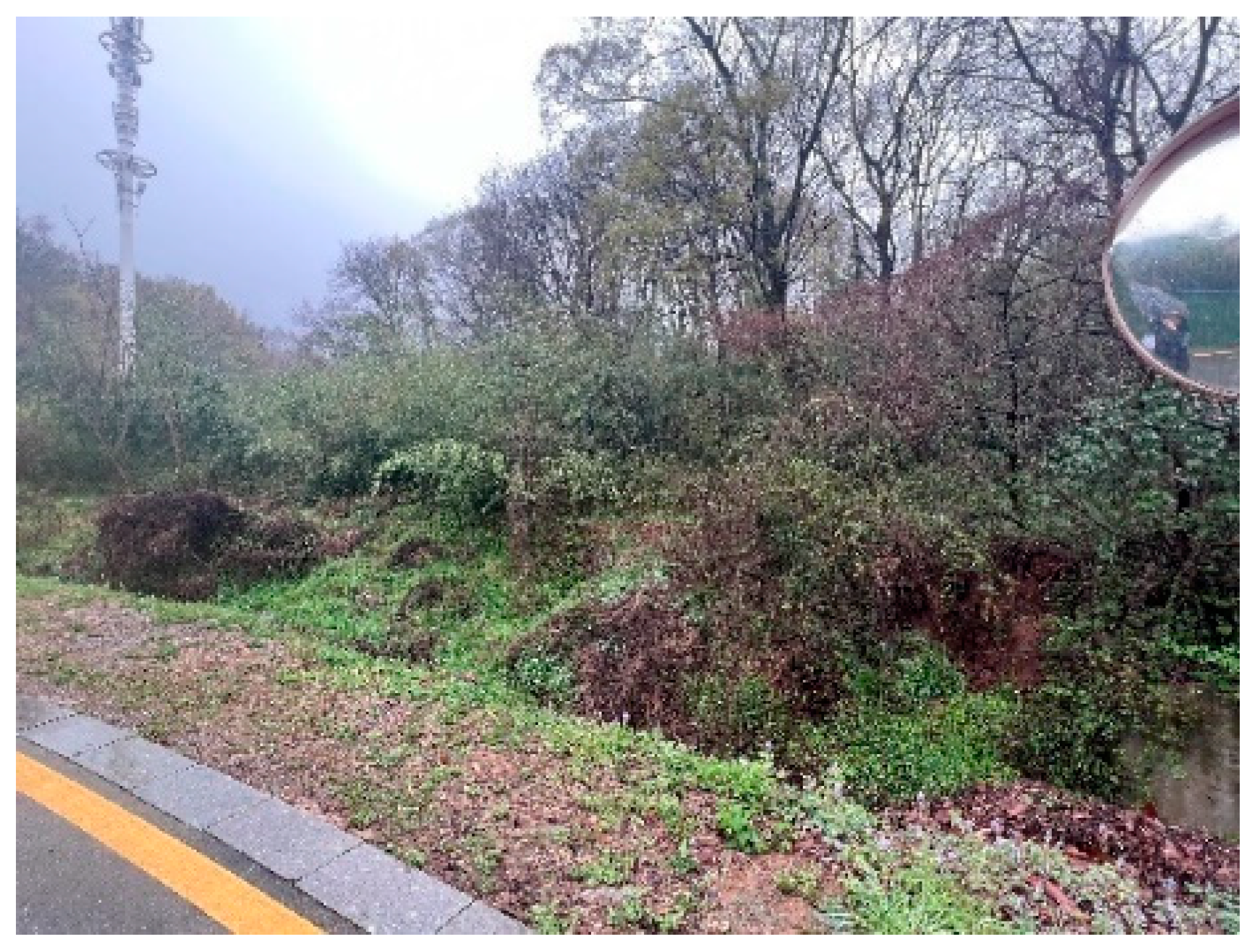
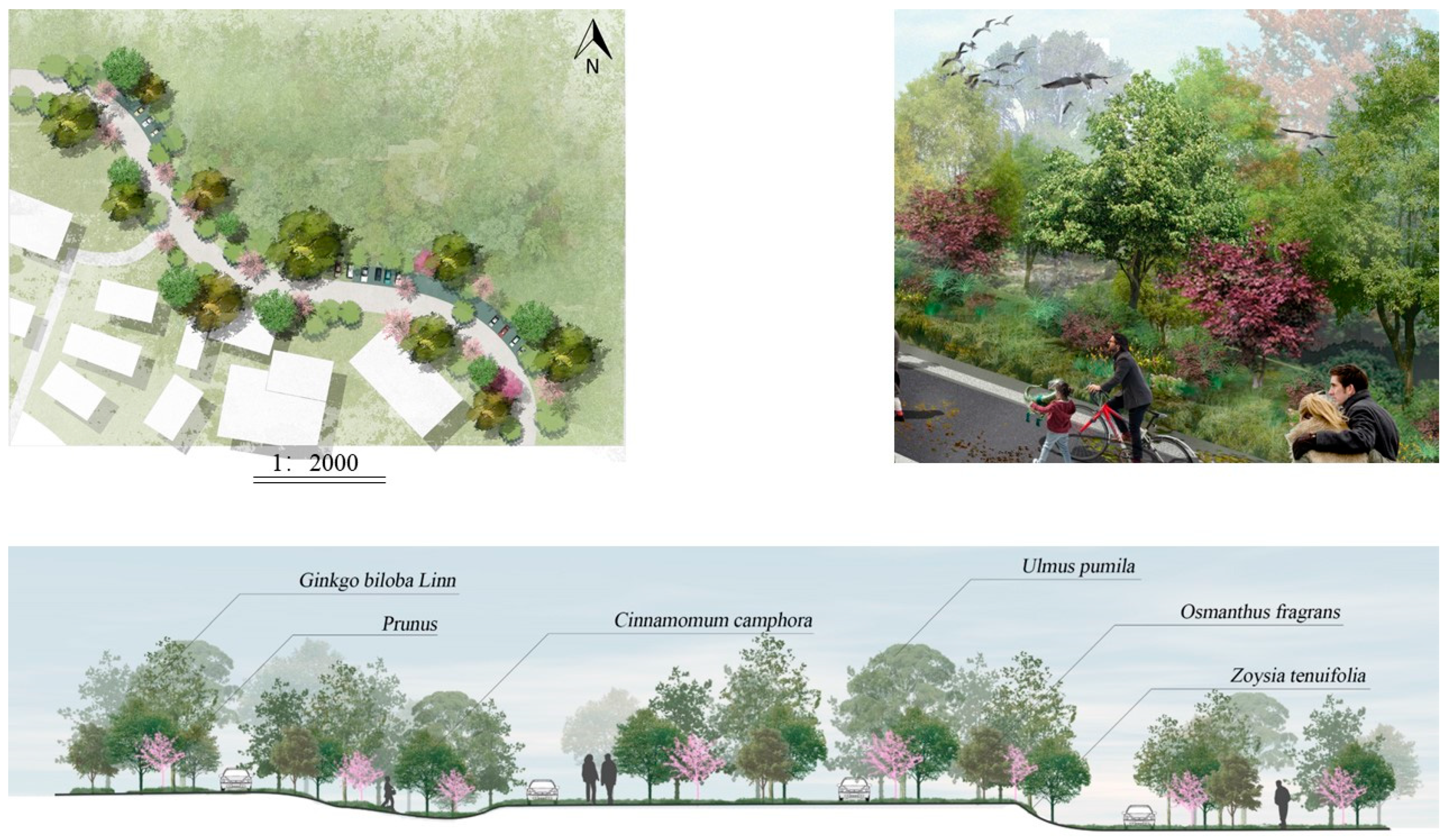
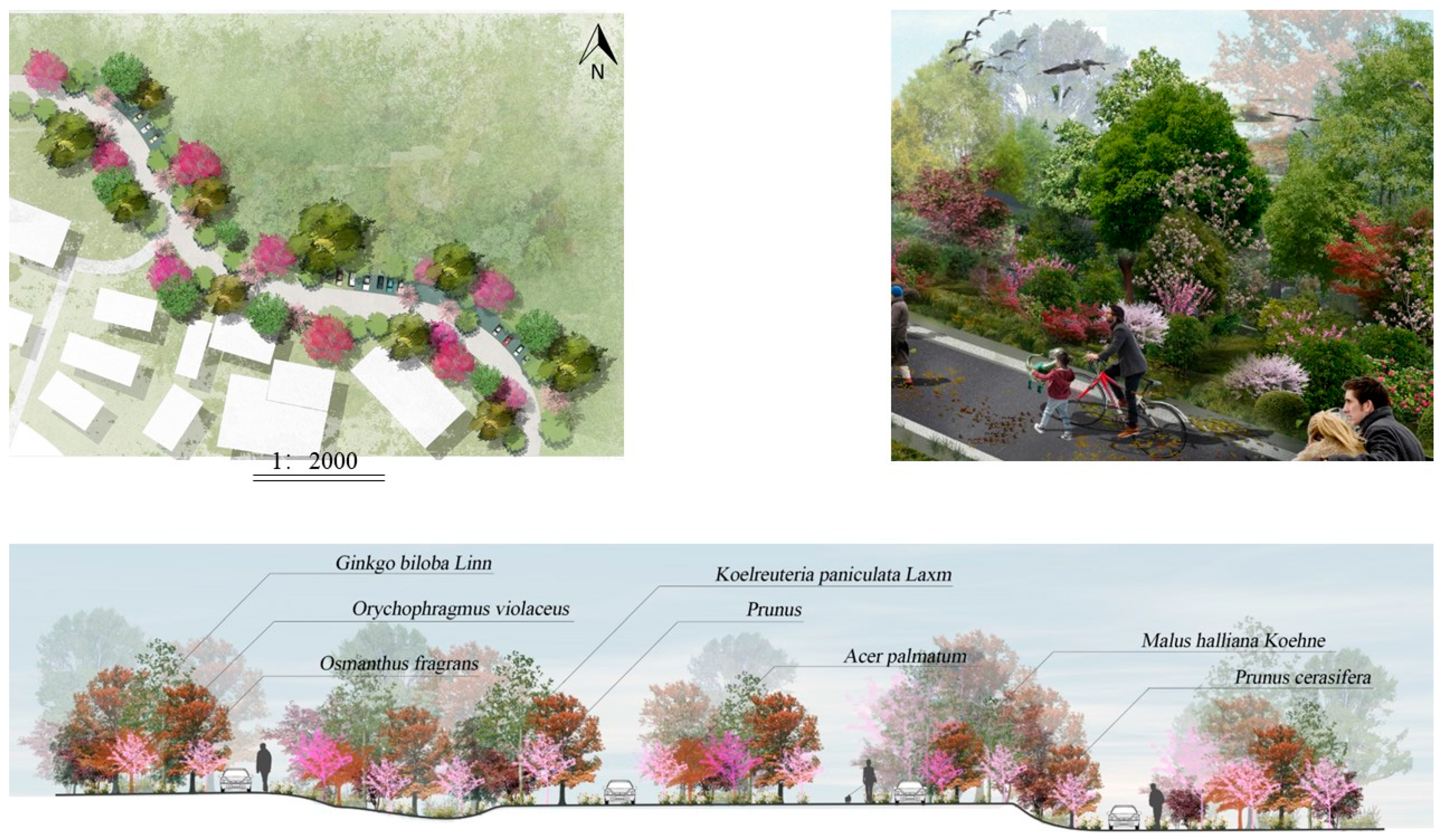
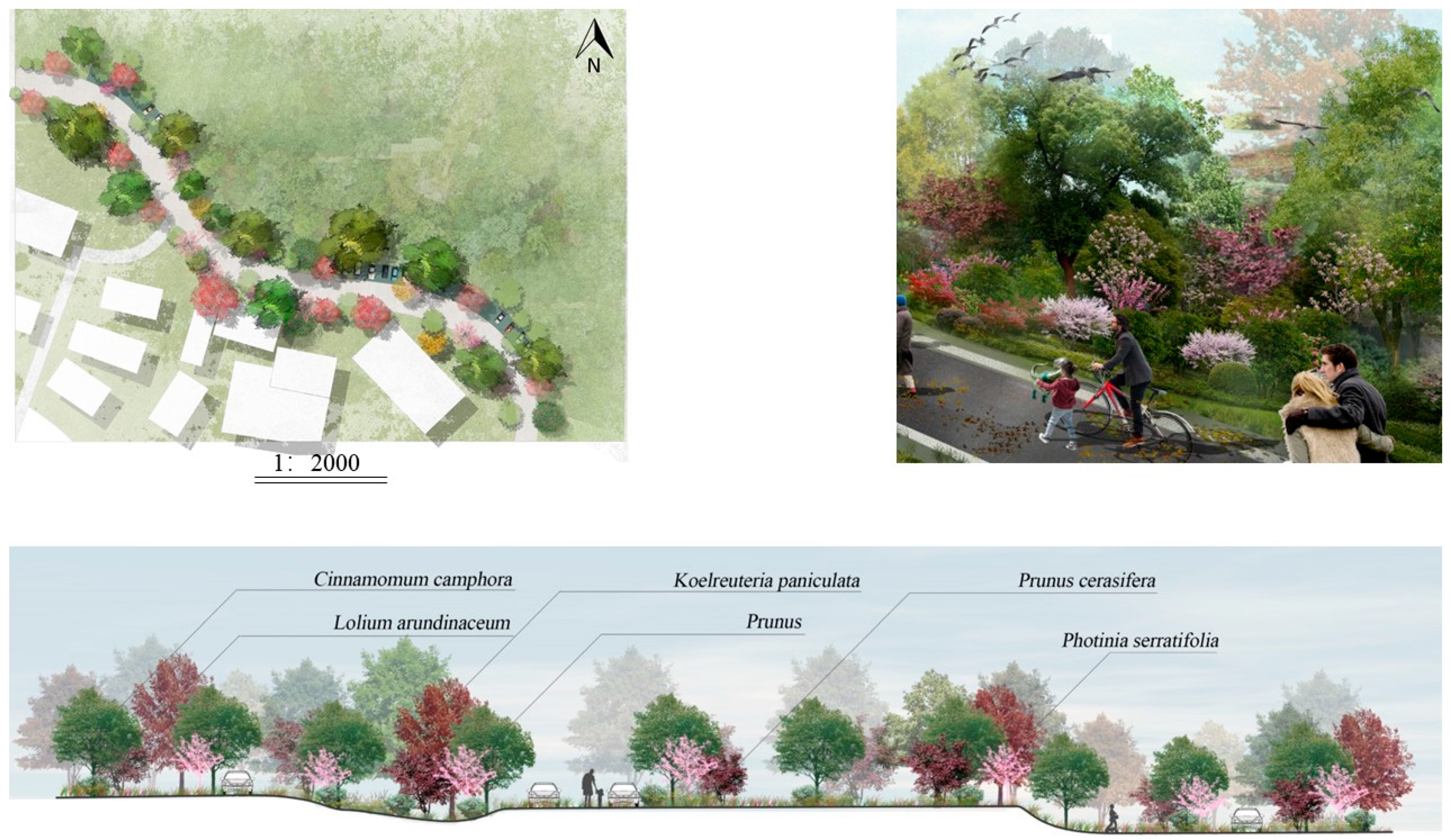
| Ecological Service Benefits | Impact Factor | Calculation Method | Base Price |
|---|---|---|---|
| Energy saving benefits | Leaf area index Canopy coverage | Based on reducing or increasing the amount of electricity and natural gas consumed at the same temperature as the tree community | Electricity Natural gas prices |
| Carbon sequestration benefits | Chest diameter distribution Canopy coverage Tree growth | A carbon tax based on the same amount of CO2 for direct carbon storage and indirect carbon reduction | Carbon tax |
| Improved air quality | Tree species Canopy coverage | The amount of tax levied on the same amount of air pollutants emitted by direct absorption, indirect abatement, and BVOC emissions | Air pollution tax amount |
| Rainwater retention benefits | Annual precipitation Leaf area index Canopy coverage | The government’s annual funding for heavy rainfall and soil erosion control, based on direct canopy retention, profile protection of water quality, and flood control | Government stormwater management funds |
| Aesthetic value | Location factors Tree species Tree growth | Increase in the sales price of surrounding houses based on the location and annual growth of the tree leaf area | The average price of houses in the city |
| Cinnamomum camphora | Distance from the Building (ft.) | Direction of the Tree from the Nearest Building | Light Intensity | Current Year Earnings/RMB | More than 20 Years of Earnings/RMB |
|---|---|---|---|---|---|
| DBH: 16 in. Growth status: outstanding | >60 | / | Full | 75.64 | 2001.63 |
| Part | 61.20 | 1432.91 | |||
| Shade | 54.05 | 1222.43 | |||
| ≤60 (Take 0–19 ft. for example) |  | Full | 472.53 | 9939.82 | |
| Part | 458.09 | 9371.09 | |||
| Shade | 450.93 | 9160.62 | |||
 | Full | 316.23 | 6825.90 | ||
| Part | 301.79 | 6257.18 | |||
| Shade | 294.64 | 6046.70 | |||
 | Full | 348.62 | 7461.32 | ||
| Part | 334.18 | 6892.60 | |||
| Shade | 327.03 | 6682.13 | |||
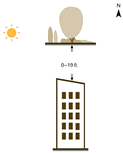 | Full | −28.47 | −84.99 | ||
| part | −43.11 | −653.71 | |||
| Shade | −50.26 | −864.19 |
| Tree Species | Growth Status | Light Intensity | Average Breast Diameter/cm | CO2 Absorption/kg | Average Benefit per Plant/RMB | Total Benefits/RMB |
|---|---|---|---|---|---|---|
| Ulmus pumila | Good | Full | 38.0 | 465.48 | 186.81 | 747.24 |
| Salix babylonica | Good | Full | 20.5 | 298.72 | 118.34 | 710.04 |
| Pinus | Excellent | Full | 32.0 | 290.88 | 127.61 | 255.22 |
| Cinnamomum camphora | Excellent | Full | 31.9 | 185.13 | 109.48 | 25,837.28 |
| Osmanthus fragrans | Excellent | Full | 12.3 | 124.77 | 56.87 | 568.7 |
| Ginkgo biloba | Good | Full | 20.2 | 114.85 | 66.48 | 465.36 |
| Prunus serrulata | Excellent | Full | 13.0 | 92.74 | 47.53 | 190.12 |
| Prunus cerasifera | Excellent | Full | 7.5 | 42.15 | 22.60 | 45.2 |
| Metasequoia glyptostroboides | Excellent | Full | 52.0 | 39.04 | 80.84 | 565.88 |
| Malus halliana Koehne | Excellent | Full | 6.7 | 32.64 | 16.07 | 144.63 |
| Acerpalmatum Thunb | Excellent | Full | 10.6 | 32.30 | 20.81 | 187.29 |
| Sophora japonica | Excellent | Full | 5.0 | 29.71 | 16.21 | 16.21 |
| Prunus cerasifera | Excellent | Full | 5.0 | 28.50 | 14.97 | 14.97 |
| Magnolia denudataDesr. | Good | Full | 6.1 | 27.45 | 15.25 | 45.75 |
| Magnolia grandiflora | Excellent | Full | 41.0 | 9.29 | 109.41 | 109.41 |
| Broussonetia papyrifera | Excellent | Full | 30.4 | 6.21 | 39.42 | 197.10 |
| Gleditsia sinensis | Common | Full | 19.0 | 3.58 | 32.28 | 32.28 |
| Koelreuteria paniculata Laxm | Good | Shade | 39.5 | 2.90 | 78.02 | 156.04 |
| Type | Plant Community Structure | Target Functionality | Recommended Plant Configuration Mode |
|---|---|---|---|
| Functional plant clusters based on plant carbon sequestration capacity | Shrubs Ground cover | Mainly carbon sequestration function | Hosta plantaginea + Ophiopogon japonicus − Photinia + Jasminum nudiflorum + Ligustrum sinense Lour + Loropetalum chinense var.rubrum + Spiraea salicifolia L. + Lonicera maackii + Chimonanthus praecox |
| Ground cover | Mainly carbon sequestration function | Sedum sarmentosum Bunge + Taraxacum mongolicum + Sanguisorba officinalis + Chrysanthemum indicum + Penstemon digitalis + Stachys lanata Jacq | |
| An ornamental plant cluster dominated by seasonal plants | Shrubs Ground cover | Mainly landscape function | Oxalis corymbosa DC + Kerria japonica + Amygdalus triloba + Photinia + Rosa chinensis jacq + Buxus megistophylla |
| Ground cover | Mainly landscape function | Phalaris arundinacea + Juncus effusus L. + Ophiopogon japonicus + Pennisetum alopecuroides + Iris tectorum Maxim + Cynodondactylon + Iris pseudacorus + Dianthus plumarius | |
| A fusion of plants that are both functional and ornamental | Shrubs Ground cover | Balanced carbon sequestration and landscape benefits | Osmanthus fragrans + Pittosporum tobira + Nandina domestica + Photinia + Acerpalmatum Thunb |
| Ground cover | Balanced carbon sequestration and landscape benefits. | Fruticosa + Juncus effusus + Carex giraldiana Kukenth. |
Disclaimer/Publisher’s Note: The statements, opinions and data contained in all publications are solely those of the individual author(s) and contributor(s) and not of MDPI and/or the editor(s). MDPI and/or the editor(s) disclaim responsibility for any injury to people or property resulting from any ideas, methods, instructions or products referred to in the content. |
© 2024 by the authors. Licensee MDPI, Basel, Switzerland. This article is an open access article distributed under the terms and conditions of the Creative Commons Attribution (CC BY) license (https://creativecommons.org/licenses/by/4.0/).
Share and Cite
Zhu, Y.; Wang, S.; Li, Q.; Sheng, Q.; Liu, Y.; Zhu, Z. Research on the Construction and Application of Rural Digital Design Ecosystem under the “Dual Carbon” Goal—Take the Carbon Sequestration Benefits of Street Trees in Nanjing’s Bulao Village as an Example. Forests 2024, 15, 315. https://doi.org/10.3390/f15020315
Zhu Y, Wang S, Li Q, Sheng Q, Liu Y, Zhu Z. Research on the Construction and Application of Rural Digital Design Ecosystem under the “Dual Carbon” Goal—Take the Carbon Sequestration Benefits of Street Trees in Nanjing’s Bulao Village as an Example. Forests. 2024; 15(2):315. https://doi.org/10.3390/f15020315
Chicago/Turabian StyleZhu, Yueru, Siyu Wang, Qingqing Li, Qianqian Sheng, Yanli Liu, and Zunling Zhu. 2024. "Research on the Construction and Application of Rural Digital Design Ecosystem under the “Dual Carbon” Goal—Take the Carbon Sequestration Benefits of Street Trees in Nanjing’s Bulao Village as an Example" Forests 15, no. 2: 315. https://doi.org/10.3390/f15020315




